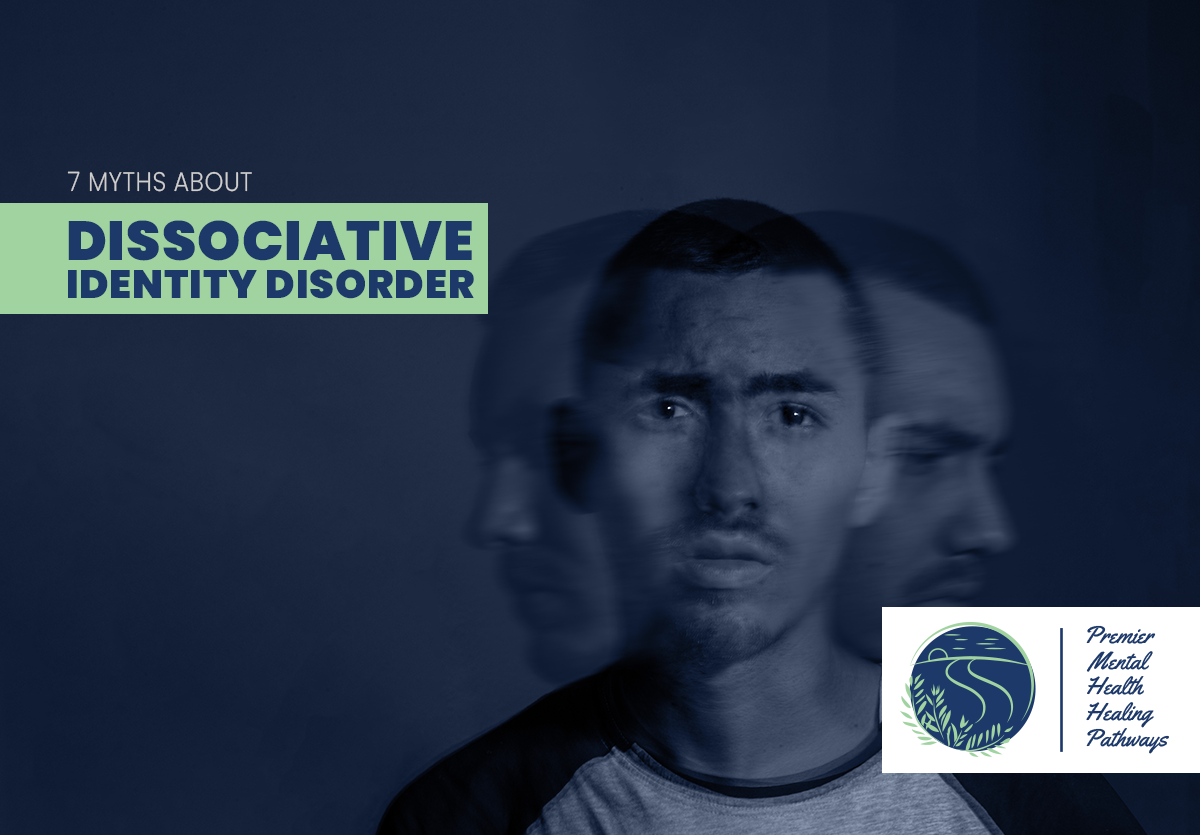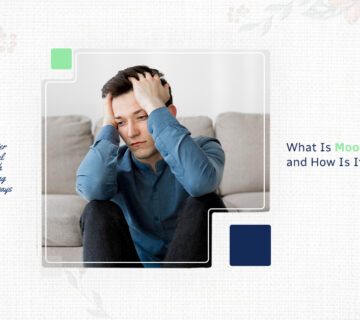Dissociative Identity Disorder (DID) is a complex mental health condition. It involves feeling like you have different personalities inside you, each controlling your actions at other times.
DID can lead to memory problems and other challenges. Various therapies can help manage these symptoms.
If you or someone you know is dealing with dissociative identity disorder, Premier Mental Health Healing Pathways can help.
We provide comprehensive care for those dealing with multiple conditions. Contact us today to learn about treatment options.
For a long time, some people doubted the validity of DID and questioned, ‘Is DID real?’ leading to many myths.
Below, we’ll outline 7 myths about dissociative identity disorder and provide facts about DID.
Understanding these facts can help people better understand the disorder and stop its stigma.
First, we talk about dissociative identity disorder (DID) in detail, so please read about it.
What is Dissociative Identity Disorder (DID)?

Dissociative identity disorder was known as split personality disorder or multiple personality disorder.
DID is when someone has different personalities that take over at other times.
Each personality has its own story, traits, likes, and dislikes. DID can cause memory gaps and make someone believe things that aren’t true.
DID is one kind of dissociative disorder. Dissociative disorders affect how you see and understand reality. Other types of dissociative disorders are:
- Dissociative amnesia, which makes it hard to remember things about yourself.
- Depersonalization or derealization disorder, where you feel disconnected from your actions.
Dissociative Identity Disorder Alter Types
So, let’s discuss “What are the different types of alters in dissociative identity disorder?
DID involves the presence of multiple distinct identities within an individual.
These identities, also known as “alters,” can vary in several ways. It includes age, gender, temperament, and even physical characteristics.
In DID, each may have its unique name, preferences, memories, and way of interacting with the world.
Some alters may be aware of each other, while others may not be.
The different types of alters DID include:
- Primary Host
It is the core identity that typically carries out day-to-day functioning and interacts with others in everyday life.
- Child Alters
These alters represent younger aspects of the individual’s personality. They may exhibit childlike behaviors, emotions, and needs.
- Adolescent Alters
These alters represent teenage aspects of the individual’s personality. They may display characteristics typical of adolescence, such as rebelliousness or moodiness.
- Protector Alters
These may emerge to protect the individual from perceived threats or harm. They may be more assertive, aggressive, or vigilant compared to other alters.
- Persecutor Alters
These may hold traumatic memories or negative beliefs about the self or others. They may exhibit hostile or self-destructive behaviors.
- Helper Alters
These alters may emerge to provide support, comfort, or guidance to the individual or other alters. They may be nurturing, compassionate, or wise.
7 Myths About Dissociative Identity Disorder
Myth 1: DID Is Rare
Fact: Dissociative identity disorder can affect as many as 1.5% of people in the global population.
While DID may not be as prevalent as some other mental health disorders, it is more common than often believed.
Studies suggest that DID affects around 1.5% of the global population, making it far from rare.
However, it is frequently underdiagnosed or misdiagnosed due to its complexity and the stigma associated with it.
Myth 2: DID Is the Same As Schizophrenia.
Fact: Dissociative identity disorder and schizophrenia are distinct disorders.
The confusion between DID and schizophrenia arises from a narrow focus on certain symptoms. DID involves multiple personalities within one person
In schizophrenia, individuals have false beliefs. They may also experience hallucinations, seeing or hearing things that aren’t real.
Myth 3: Individuals With DID Are Violent.
Facts: Individuals with this condition are not more prone to violence than others.
Most of what people think about Dissociative Identity Disorder (DID) comes from movies and TV. They usually show people with DID as scary kidnappers or killers, which is not true.
But in reality, they’re more likely victims of violence, with over 90% experiencing trauma in childhood.
Having DID also makes people more likely to hurt themselves or try to kill themselves.
Studies indicate that over 70% of people with DID have tried to kill themselves at least once.
Myth 4: Dissociative Identity Disorder Is a Form of Personality Disorder.
Fact: Dissociative Identity Disorder and personality disorders are not the same.
DID is not a personality disorder. Dissociative Identity Disorder is a type of dissociative disorder meaning, people feel disconnected from themselves. The dissociative disorder often starts in childhood.
Personality disorders, on the other hand, involve having certain traits that make it tough to live a stable life.
Myth 5: Dissociative Identity Disorder Is An Unreal Condition.
Fact: Dissociative Identity Disorder (DID) is a genuine and identifiable mental health condition.
Dissociative Identity Disorder (DID) is a real mental health problem. It happens when someone feels like they have different personalities inside them.
These personalities have their thoughts and behaviors. Even though people used to argue about whether is DID real? Now we know it’s a genuine disorder caused by severe trauma.
Myth 6: People with DID Cannot Lead Fulfilling Lives.
Facts: People with DID can lead fulfilling lives with support and treatment.
Living with Dissociative Identity Disorder can be tough, but with the right help, many people can still have fulfilling lives.
Therapy, medication, and a supportive environment can make a big difference.
With these supports, people with DID can manage their symptoms, become stronger, and go after their dreams.
Myth 7: DID Cannot be Treated Successfully
Facts: Several therapies are effective.
Contrary to what many people think, those with DID can become one person with the help of therapy. There are different kinds of treatment available, and most people get better with it.
While there aren’t specific medicines for DID, some drugs can help with other problems that come with it.
Borderline Personality Disorder VS Multiple Personality Disorder
Borderline Personality Disorder (BPD)
People with BPD have trouble with their emotions and relationships.
They may feel very scared of being abandoned, have big mood swings, and act impulsively.
Multiple Personality Disorder (known as Dissociative Identity Disorder)
In DID, a person has more than one “self” inside them.
These different selves can act like other people, and the person might not remember what happens when one of these selves is in control.
So, while both involve difficulties with the self, BPD focuses on emotions and relationships, while DID consists of having multiple identities.
Management and Treatment for DID
Therapy methods like Talking therapy, hypnosis, and EMDR can be really useful, especially for those people who’ve been through trauma.
Therapy helps with:
- Dealing with past pain.
- Handling sudden changes in behavior.
- Putting all your different identities together.
Can Hypnosis Help with DID?

Some doctors may suggest hypnotherapy along with regular therapy. Hypnotherapy is like guided relaxation that could help bring back forgotten memories.
Let’s Wrap up 7 Myths About Dissociative Identity Disorder
Dissociative Identity Disorder (DID) is a complex mental health problem that has a lot of wrong ideas around it.
By explaining these wrong ideas and making more people understand, we can help those with DID have an easier time.
It’s important to teach and spread awareness to help anyone with mental health struggles, including those with DID.
At Premier Mental Health Healing Pathways, we use Hypnotherapy to help people feel better mentally.
Our team helps guide individuals through hypnotherapy to make good changes and find balance in their lives.
FAQs
Can dissociative identity disorder (DID) be cured?
Treatment focuses on managing symptoms and improving quality of life rather than aiming for a cure.
How common is dissociative identity disorder (DID)?
DID is rare, but its exact prevalence is uncertain due to underdiagnoses.
Are all alter aware of each other?
No, some alters may not be aware of others, while some may have partial awareness.
Is schizophrenia and multiple personality disorder the same?
No, schizophrenia and multiple personality disorder are not the same.
Can dissociative identity disorder develop in adulthood?
Yes, although it originates from childhood trauma, it can be diagnosed in adults.
What causes dissociative identity disorder?
Severe childhood trauma, such as abuse, is a primary factor in the development of DID.
Is medication effective for treating DID?
Medication may help manage associated symptoms like depression or anxiety, but it’s not a primary treatment for DID itself.
Which of the following is false of dissociative disorders?
- Biological factors mostly cause dissociative disorders.
- Dissociative amnesia is a type of dissociative disorder involving memory loss.
Biological factors mostly cause the statement “Dissociative disorders” to be incorrect. Dissociative disorders are caused by psychological factors such as trauma, not biological ones.






No comment